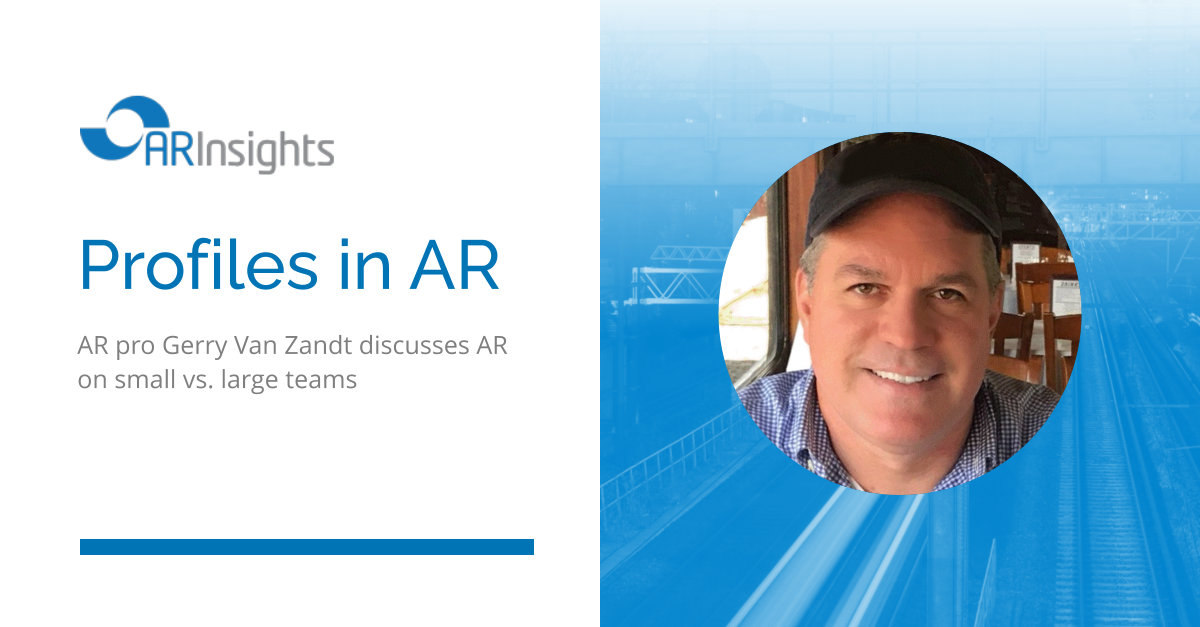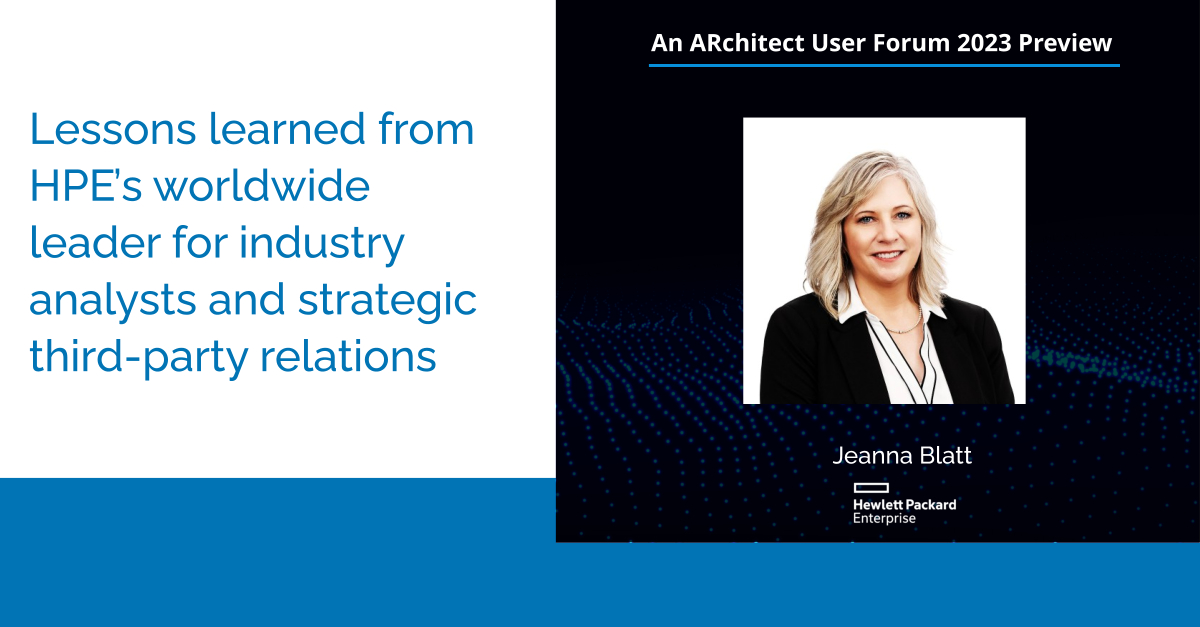Analyst relations readers, you’re in for a treat! Our latest “Profile in AR” features Gerry Van Zandt, senior director of analyst relations at analytics automation company Alteryx. Gerry has been a staple in the AR field for nearly three decades — previously managing global analyst relations for Oracle, HP, Intel and more, and serving on the Institute of Influencer & Analyst Relations (IIAR>) board of directors.
Gerry’s wealth of experience is reflected in the many great tips and insights he shared with us. Part I of that interview is below – describing Gerry’s career journey and how he’s successfully moved from working with dozens of AR colleagues at large, multinational companies, to now being a one-man AR show. (Stay tuned for Part II of the conversation, with other best practices and advice from Gerry, next week!)
Q: We’d love to hear about your career journey. What led you to analyst relations?
Gerry: I started out in tech PR in the early ‘90s. While working at a PR agency in Silicon Valley, I worked as an embedded PR contractor at HP’s Cupertino site for two years. I started doing analyst relations in that role and really enjoyed it.
Then in 1995, I went to work for another agency: Waggener Edstrom (now WE Communications). While I was there, I helped launch an e-commerce start-up called Pandesic, an SAP and Intel joint venture — overseeing the AR and PR aspects of the launch.
When it was over, Intel said to me, “We’d like you to come work for us in an analyst relations capacity.” The company was just creating a dedicated AR team; I was one of the original members. I had a fantastic and wise manager, Mike Green, and served on Intel’s AR team for three years. Afterward, I took on marketing campaign management and branding positions at Intel. But the time away from AR felt like time in the wilderness! I felt things were lacking in my career, and I knew I needed to get back into analyst relations.
So I went to work at another PR agency and did more AR (along with PR) there. Then in 2008, things came full circle, and I took an AR role at HP — as an employee this time. I did analyst relations there for seven-plus years. Again, I was lucky to have a very supportive and excellent manager: Emily Neumann, who’s now doing PR at Amazon. Toward the end of my tenure, I was very involved in helping launch HP’s cloud.
In early 2015, I took an AR position at Oracle. They were also looking to become a cloud infrastructure provider, and I brought relevant AR expertise and analyst relationships from my time at HP. During my six years there, Oracle went from being an on-prem software company to becoming a full-on cloud software and infrastructure provider.
I was ready to move on and make a difference at a new organization. I also wanted to run my own show. I’d been a member of a 15-person AR team at HP and a 35-to-40-person team at Oracle. Now at Alteryx, I lead the AR function as a single person. I’m exactly a year into my role here, and as with any job, it has its challenges, but also great rewards. There’s never a dull moment!
Q: Having done AR in both big-team and small-team environments, what differences do you see? What similarities?
Gerry: In AR, there are some things that stay the same, no matter what size or type of program you’re working with. The importance of relationships, industry and product knowledge, personal integrity and the ability to get things done — those all remain constant for AR pros. No matter the size of your team, you also have to ensure that your AR program is tightly aligned with, and directly supporting, the company’s strategic and marketing goals, and contributing to its business objectives.
And now onto some differences!
Well, on large teams, you get access to a lot of research — which is manna to a chronic research junkie like me. You also have skilled AR colleagues to collaborate (and commiserate!) with, and a lot of resources to pursue AR activities, events and programs. Working for a large firm can open a lot of doors for AR pros.
Also, when you’re part of a bigger team, too, your role is more defined. You’re somewhat in a box; you’re typically working on a specific product area, with a specific set of analysts, executives, product leaders and marketing people.
And you don’t have as much administrative stuff to deal with. That’s kind of nice. It allows you to focus more on AR activity and be a little more thoughtful, in terms of being strategic.
In contrast, on a smaller AR team, or if you’re a one-man shop, you tend to interact with a lot more people and departments within the company. For example, I support and collaborate with numerous teams inside of Alteryx — corporate strategy, the executive suite, product marketing, product management, corporate marketing, sales and engineering. And then there are the web design, marketing campaigns, content development, customer advocacy, PR and social media colleagues, internal and exec comms, and the people who run our customer community. I work with them all.
So on smaller teams, there’s an opportunity to have great visibility and impact, but with that comes responsibility and scrutiny. You often need to demonstrate accountability more to internal stakeholders. There’s also a greater need to prioritize your time and resources to execute the most effective AR program possible. You have to make time for both planning strategy, and also executing your programs.
And on small and one-person teams, there’s a lot more diversity in your role. You’re managing and driving everything yourself. I manage our AR budget, for instance, and as part of that, I negotiate contracts with our various analyst firms — trying to get the best deals and making decisions on the mix of services. It seems like I’m also doing POs every week for different projects; at Oracle, I might have done one or two POs a year!
That’s on top of the regular analyst relations work, of course. I work actively with 10-to-12 analyst firms, and support 50-to-60 analysts, to varying degrees. Some are higher priorities, because they’re doing research and need to know what we’re doing. Others I respond to more reactively out of necessity. I also have an extended group — a total of about 130 analysts — that I reach with periodic communications, like our quarterly newsletter.
And as a one-man shop, I’m responsible for our analyst function globally. Recently, I’ve been ramping up our activity with some of the regional-focused firms, like PAC and BARC in EMEA. They’re important and quite relevant, and we need to be covering all our bases.
Q: Can you speak more to the impact that AR leaders can have at small companies?
Gerry: Yes! I’m glad you asked about that. If you’re part of a smaller team or one-man AR band, I think you actually have an opportunity to have a greater impact on the business.
Now in my role, I can see — more directly — the results of my activity. So, for example, if I engage closely with a firm and a positive analyst report comes out of it, I’m able to get that directly to the content marketing team and the sales leadership to use. At Oracle and HP, it was very rare that I worked with sales. But now at a smaller company, more people know me and come to me, so AR can help support their needs better.
In order to make the biggest impact, it takes planning. I advise meeting often — at least quarterly — with your internal executive stakeholders, so you’re up to speed on what their objectives are, and can adjust your program focus accordingly. Be prepared to justify your AR budget and key program activities when asked, with measurement data and ROI if possible.
It also helps to be proactive in sharing AR plans with your executive team and stakeholders, even if it’s just a “mini plan” overview. I do this at least twice yearly. This aligns nicely with the AR planning process too. I like to plan by the half-year, so for example, here in April 2022, I’m already well underway with 2H 2022 AR program planning.
Q: But with AR professionals (especially those on small teams) pulled in so many directions and saddled with more administrative work, how can they find time to plan and make an impact?
Gerry: It definitely requires a lot of self-discipline. I think a lot of people like to go to meetings; it makes them feel busy. Not that they’re not contributing, but to really move the needle in AR, you have to have a good sense of prioritization.
That’s something I struggle with too. But I have learned over the years how to stay in my lane, and where to and not to engage. I think that’s important.
AR pros should evaluate their schedules too. I think if you’re spending more than 20% of your time on administrative stuff, that’s probably too much. By administrative stuff, that’s POs, contracts, expense reports, budgeting, and any HR tasks, like compliance training (I just finished 6 hours of that!). I lump that all together in administrative overhead time.
Q: Can you discuss differences in AR program management strategies, in large teams vs. small ones?
Gerry: As I mentioned, prioritization — while always important for AR — is crucial for smaller programs. Knowing what programs to own and drive, versus contribute to and/or partner with colleagues on, is the essential skill here. Using tools like ARchitect to help rank, tier, prioritize and track AR activity is an invaluable element of this prioritization.
On larger teams, AR tends to manage more siloed and individual programs that support individual business units or product lines. You have to be careful though; with different owners and different levels of visibility, this can sometimes mean that the AR left hand doesn’t know what the right hand is doing. This is when effective AR leadership comes into play to ensure the individual programs are in sync, and everyone is rowing the boat in a consistent direction.
Q: How important is it to communicate AR results?
Gerry: So important! And actually, as part of a smaller team, you need to be the one to broadcast those successes. In my current role at Alteryx, communicating AR success upward and outward is a key focus for me this year. I didn’t have to worry about it as much when I was on bigger teams. At Oracle, for instance, we had an SVP of AR: Ricarda Rodatus, a very experienced AR leader. She has strong relationships in the high echelons in the company and is the face of AR to Oracle’s executive leadership. I didn’t have to broadcast my success individually, because Ricarda and her leadership team would do that for us.
At Alteryx, though, as a one-man team, I have to more regularly communicate AR’s successes — large and small — in terms of sharing analyst insight, demonstrating positive results and publicizing AR wins inside the company. And the reception is great! As an example, I recently sent out an email pretty broadly to the marketing team and executive team — sharing four analyst reports, from four different firms in the past two weeks, all featuring Alteryx quite favorably. The feedback was: “We want to see more of this; we really enjoy seeing these successes!” And our CMO sent my note to some other leaders in the company — prompting a whole thread of conversations and awareness among people who, the CMO felt, needed to know and use what I’m doing in their own efforts. Several other executive leaders asked me to share these summaries with their teams as part of my internal distribution.
That was very gratifying, and I’ll continue to do more sharing like that. So bottom line: as a one-man team, or part of a small team, you need to take the time to package and share your wins. As I mentioned earlier — communicate outward and upward.
***
Many thanks to Gerry for his fascinating take! If you want to connect with Gerry, you can reach him on LinkedIn.
And stay tuned for more of Gerry’s insights! Part II of our conversation, where he shares his thoughts on the evolution and future of AR, will publish next week.




